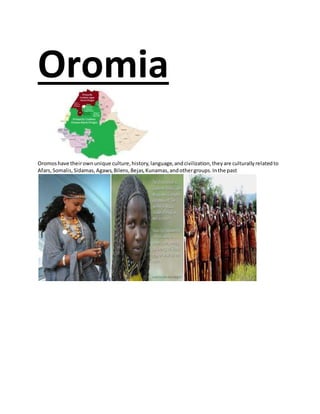
oromo people's photo gallery
- 1. Oromia Oromoshave theirownunique culture,history,language,andcivilization,theyare culturallyrelatedto Afars,Somalis,Sidamas,Agaws,Bilens,Bejas,Kunamas,andothergroups.Inthe past
- 4. .
- 5. Tourist attractions in the region
- 6. Gadaa
- 7. Gadaa (in older spelling: Gada) is the traditional social stratification system of Oromo males in Ethiopia and northern Kenya; it is also practiced by the Gedeo people of southern Ethiopia. Each class, or luba, consists of all of the sons of the men in another particular class. The entire class progresses through eleven different grades, each based on an eight-year cycle, and each with its own set of rights and responsibilities. As of 1990, Gadaa had active adherentsonlyamongthe Boranaand Guji groupsnear the Ethiopian- Kenyanborder.Thoughthe Gadaa systemitself isnolongerwidelypracticed,itremains influential in Oromosocietyat large.Historically,ithasbeenseenasabettermethodof governingthanotherforms inthe region.However,the Gadaahad all the shortcomingandproblemslike thatof the monarchial Oromoand monarchial non-OromoEthiopiansystemsof governance.[citation needed] Inregionswhere the OromoInvadedandconquered,includingaroundthe SidamaandSomali,the Gadaasystemwas oppressive inpractice,thoughproclaimedasdemocraticandjustin Oromooral tradition.Accordingto ethnohistorianUlrichBraukämper,minoritiesandthose whoassimilated,like the Hadiyya,were "consideredtobe of a lowersocial statusthanthe 'pure'Oromo anddid notpossessequal rightsinthe Gadaa system."[1]
- 9. Irrechaa Irreechaa (Amharic: ኢሬቻ), also called Irreessa, is Thanksgiving holiday of the Oromo people in Ethiopia.[1] The Oromo people celebrate Irreechaa to thank Waaqaa (God) for the blessings and mercies they have received throughout the previous year. The thanksgiving is celebrated at the sacred grounds of Hora Harsadi (Lake Harsadi), Bishoftu, Oromia. The Irreechaa festival is celebrated every year at the beginning of Birraa (the sunny new season after the dark, rainy winter season). Irrecha is celebrated throughout Oromia and around the world where diaspora Oromos live especially North America and Europe.[2] The Oromo people consider the winter rainy season of June to September as the time of difficulty. The heavy rain brings with it lots of things like swelling rivers and floods that may drown people, cattle, crop, and flood homes. Also, family relationship will severe during winter rain as they can't visit each other because of swelling rivers. In addition, winter time could be a time of hunger for some because of the fact that previous harvest collected in January is running short and new harvest is not ripe yet. Because of this, some families may endure food shortages during the winter. In Birra (the season after winter in Oromoland), this shortage ends as many food crops especially maize is ripe and families can eat their fill. Other crops like potato, barley, etc. will also be ripe in Birra. Some disease types like malaria also break out during rainy winter time. Because of this, the Oromos see winter as a difficult season. However, that does not mean the Oromo people hate rain or winter season at all. Even when there is shortage of rain, they pray to Waaqaa (God) for rain. The Oromo people celebrate Irreechaa not only to thank Waaqaa (God) but also to welcome the new season of plentiful harvests after the dark and rainy winter season associated with nature and creature. On Irreechaa festivals, friends, family, and relatives gather together and celebrate with joy and happiness. Irreechaa festivals bring people closer to each other and make social bonds. Moreover, the Oromo people celebrate this auspicious event to mark the end of rainy season, known as Ganna, was established by Oromo forefathers, in the time of Gadaa Melbaa in Mormor, Oromia. The auspicious day on which this last Mormor Day of Gadaa Belbaa - the Dark Time of starvation and hunger- was established on the 1st Sunday of last week of September or the 1st Sunday of the 1st week of October according to the Gadaa lunar calendar has been designated as National Thanksgiving Day by modern-day Oromo people.
- 12. The Region is known by Coffee
- 13. The Oromo Liberation Front (OLF;Oromo: Adda Bilisummaa Oromoo orABO) isan organizationestablishedin1973 by Oromonationaliststopromote self-determinationforthe Oromo people against"Abyssinian colonial rule".Itwasthe culminationof over70 yearsof uncoordinated resistance byOromosagainstAmharahegemonyaswell asoppressionandsuppressionof the Oromo people andtheirculture.[1][2] Ithasbeenoutlawedandlabeleda terroristorganizationbythe Ethiopian government.